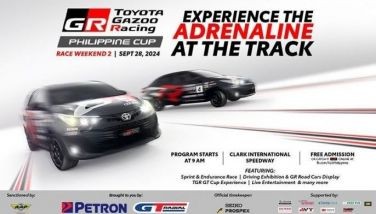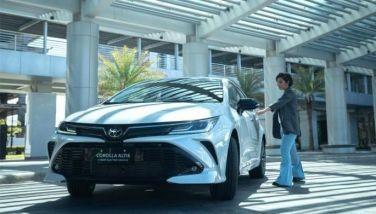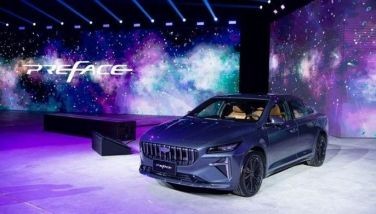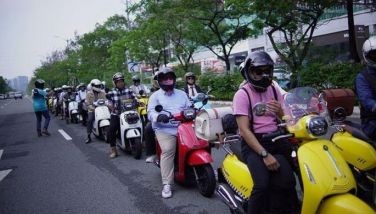28 ways to solve the traffic problem, seriously
The helplessness is paralyzing and frustrating when you’re driving nowhere fast. You slip in and out of consciousness—arms folded on the steering wheel, ingesting noxious fumes that hang like a thick fog upon the massive serpentine procession that you’ve unwillingly been conscripted for.
Day in and day out, that’s what we do: give up. Heave a sigh, lurch forward a few meters, stop, then repeat ad nauseum. You are reduced to staring at the fuel needle as it inevitably starts on its southward travel to indicate how much of your money has gone down the drain because of gridlock. Is all hope lost—just like the billions siphoned off public coffers since the start of a notion of government?
In the spirit of The Philippine STAR’s 28th year, I humbly present 28 (yes, 28) sure-fire ways to improve the traffic situation—with some help from the Automobile Association Philippines president Augusto “Gus” Lagman. Regardless of whether these are short- or long-term solutions, there’s belief that they are sound, logical, and definite steps in the right direction. One can only fervently hope many or all of these suggestions will one day see fruition—and not be caught in gridlock.
1. Improve enforcement.
Lagman contributes this nugget, ruing to The STAR that “motorists acquire bad driving habits because they are not apprehended when they violate traffic rules.” We hasten to add what many have already opined: That there must be a unified and systematized policy or schedule of penalties across the Metropolitan Development Authority (MMDA), the Philippine National Police (PNP), and local government units.
2. Instill biker discipline.
A significant percent of all road accidents involve motorcycles. It starts with wearing a helmet, but doesn’t end there. Let’s be honest: How many riders have you seen that text while on the road? Many cause traffic, too, by recklessly cutting through lanes and in front of vehicles. Some bikers think that traffic lights do not apply to them, and make a jackrabbit start even before the light turns green. Tsk tsk.
3. Create a Bus Rapid Transit (BRT).
“Most of the traffic chokepoints are in bus stops. BRT could be one way of solving this,” continues Lagman. A BRT system is one that has “specialized design, services, and infrastructure to improve system quality (while removing) typical causes of delay.” The basic idea is to combine the “capacity and speed of light rail or metro with the flexibility, lower cost and simplicity of a bus system.” Two words for you: POLITICAL WILL.
4. Free us from wang-wang thugs.
I wonder whether foreigners arriving at the NAIA get what that “Wang-wang Free Zone” sign at the terminal is all about. Filipinos though, surely, must just wryly smile at it now. Have you noticed that these official bullies have made a comeback on the roads—from the motorcycle-riding hawi boys, to the SUV-bound thugs who wave you away as if their boss bought the pavement you’re all driving on? The sirens may be off a lot of times but these overblown VIPs and their attendant sharks are back.
5. Underground rail system.
Gus Lagman: “The only long-term solution to Metro-Manila’s transportation problem is a heavy-rail transit system—underground. Even with modern TBMs (tunnel-boring machines) it will still probably take three to five years to operationalize just one line, and so, for this reason, we must start now! Using the public-private partnership (PPP) scheme, our finances need not be drained. What’s more, digging and constructing underground will not disturb ground-level traffic the way overhead structures do… We only have to look at other heavily populated metropolises in the world to know that subways are the answer to our transport problems. Tokyo, Hong Kong, New York, London, Paris, Moscow, etc.—they all have subways and so they don’t bother restricting the acquisition of private cars. In these cities, the commuters themselves decide that taking the subway is more convenient for them.”
6. Sit jeepney drivers down for a dressing down.
Seriously. They have to be made to understand how stopping in the middle of the street to let passengers alight or disembark affects everyone behind. It’s plain and simple respect for other people’s time—not to mention safety.
7. Devise and enact a decisive, mutually beneficial truck policy.
Let’s face it, we need the goods those trucks are ferrying. However, we need these drivers to practice safety and consideration on the streets. The other week, an eager articulated truck driver snagged low-lying overhead cables on Col. Bonny Serrano Avenue in Quezon City—taking down an electric post with it. Imagine the inconvenience. Some drivers have this nasty habit of taking shortcuts via inner or secondary roads where their huge vehicles don’t have any wiggle room. A real truck policy should address the whole gamut of headaches and potential problems these behemoths on wheels pose.
8. More pedestrian walkways/overpasses that are safe.
The Makati Central Business District paradigm showed that if you provide safe and convenient pedestrian options, people will naturally take to them—freeing up streets for vehicles. Light these walkways up and provide security guards. Let’s not lose more lives because of the throngs who dare to cross, say, EDSA or Commonwealth Avenue night and day.
9. Confine tricycles to where they’re supposed to be.
The right to earn a livelihood comes hand in hand with the responsibility to be considerate towards others. How many accidents have been caused by slow-moving tricycles on highways?
10. More secondary roads.
The “Christmas Lane” concept of the MMDA was a good idea because it showed people there are other routes other than our beloved EDSA. However, secondary roads also need to be free from obstructions like the roadside barangay basketball court or even carinderia.
11. Ban counterflowing.
This is not the first (or predictably last) time I’ll be griping about counterflowing idiots who appropriate the incoming lane just to get ahead. Both irritating and dangerous, offenders should be locked up in a room sans air-conditioning or electric fan.
12. Ban kotong enforcers/cops.
Easier than it sounds, but how can we get anywhere when there’s no one policing the police? Before this happens, rich motorists will always get away with anything.
13. Apprehend vendors setting up on sidewalks and roads.
As that sign goes: “Sidewalks are for people.” How else can you safely negotiate that stretch of road when someone has laid out a huge mat on the sidewalk and filled it with pirated DVDs of the latest movies?
14. Tow illegally parked vehicles.
It’s a total waste of public money to plan for and build a four-lane thoroughfare, then have only two lanes usable because of selfish people who use both sides as personal parking space. This could be forgiven on inner roads, but never for busy streets with a high volume of traffic.
15. Phase out old vehicles.
There should be no hard and fast rules as far as private cars go because different car owners treat (or love) their vehicles differently. However, buses, jeepneys, taxis, and trucks need rules that need to be stringently enforced before a lot of these public vehicles disintegrate before our eyes with catastrophic consequences.
16. Increase the number of traffic enforcers.
The MMDA recently announced it would deploy 200 enforcers on night shift—a step in the right direction for the simple reason that more unsavory characters (many of them at the wheel or handlebars) come out at night. I suggest doing the same during daytime. Until people generally smarten up, this is the easiest stopgap measure to keep traffic moving sa daang matuwid (insert snide laugh here).
17. Re-testing of all public vehicle drivers when they renew their licenses.
Gus Lagman says this should include tricycle drivers. He also forwards the idea of a “commercial license,” in addition to student, non-professional, and professional types to be issued to these public utility drivers.
18. Follow the right procedure in the issuance of drivers’ licenses.
“Even bad drivers who hardly know traffic rules and regulations can easily get a license,” Lagman correctly points out. That helps explain all the mayhem on the road.
19. Coordinate and schedule roadwork.
Paging the Department of Public Works and Highways, Maynilad, Manila Water Company, cable companies, and every tunneling mole. Get with the program. Would it be too difficult to coordinate your efforts so that there wouldn’t be any repetitious digging? There’s already too much buzz that the reason for the excavations is, well, commissions.
20. Enact stiffer fines for erring PUV drivers.
Contrary to the howls of protest from jeepney operators and drivers, methinks we need this to scare the hard-headed into submission. About the concern that this will promote kotong, well, if the threat of kotong is higher, won’t the drivers be even more careful and conscientious?
21. Re-examine the number coding scheme.
Do you realize that 19-year-olds don’t have a clue how it was like before the “odd-even” or “number coding” scheme? Now known as the UVVRP (Unified Vehicular Volume Reduction Program), government has been denying us the full use of our vehicles since 1995. It would be safe to say that since the start of its implementation, households have purchased a car or two or more to circumvent this tired program.
22. Add more MRT carriages.
Duh. An even better idea is to make our great and noble public officials ride the MRT during rush hour. See how the sardine effect suits them.
23. Increase CCTV coverage of the streets.
This should be in aid of enforcement—not to mention security and safety. An omniscient HD eye in the metropolis should go a long way to restore order.
24. Punish erring commuters.
Many times, the blame shouldn’t land squarely on the shoulders of public utility drivers. I’ve seen unthinking commuters who insist on disembarking at the snap of a finger—wherever the vehicle is on the road. Accost these commuters and make them undergo a seminar or some form of community service.
25. Round up the “batang hamog.”
They pose a danger to themselves as well as the motorists they prey on. In case you haven’t heard, these are the street kids (usually high on glue or some other substance) who pilfer goods from delivery trucks or open the doors of unlocked vehicles to steal from passengers. Where are the parents of these kids?
26. Cleanse the ranks of colorum.
Already being pursued in earnest, government truly needs to step up—whoever may be on the business end of its campaign. Again, say it with me: “Daang matuwid.”
27. Enforce the motorcycle lane.
The non-exclusive motorcycle lane was devised of as a way to curb accidents—particularly on EDSA, plus Macapagal, and the “killer” Commonwealth Avenues. After a vigorous campaign against erring riders, ningas kugon made an expected comeback. Now, even buses that have no business being on the left side of EDSA are using the lane like it’s a personal playground. Meanwhile, motorcycles themselves are all over the place—sometimes getting into terrible accidents with buses. Guess who wins that matchup?
28. Promote road courtesy.
Here’s another piece of advice from Lagman. Indeed, do people even know what zipper merging is about? Road rage often stems from ignorance about how drivers should comport themselves on the streets. Taxi drivers are particularly blissfully unaware that they’ve cut someone, for instance. You wonder if they know concepts such as right of way. Defensive driving in this country is a must only because of all the freewheeling public vehicles that will suddenly swerve into your lane when you least expect it.
- Latest





























